Susan Ball Faeder at the Milton Art Bank
If you’ve ever owned a cherished pair of jeans you couldn’t bear to part with – even long after you really should have — you will feel instantly at home when you enter the Milton Art Bank, currently displaying the work of fiber artist Susan Ball Faeder.
With hues ranging from pale sky-blue to twilight cobalt, BLUE is both the name of the show and its star. And indigo — the colorant used to dye denim — is center-stage.
For Faeder, indigo connects her life-long love of Japanese culture with her passion for textiles. As a high-school foreign-exchange student living in a provincial northern Japanese village, Susan witnessed the last of the old ways of Japan when everything was handmade and valued. Across her next 33 visits to Japan, she observed first-hand how the indigo plant is grown and fermented, the hand-dyeing process specific to indigo, the slow hand-weaving of the dyed thread into cloth, and how to construct that cloth into a garment… a process that could easily take an entire year for one kimono.
This labor-intensive process meant garments were very precious. Instead of being discarded when worn or torn, clothing was patched and stitched with care. Over time, the utilitarian but decorative mending technique known as sashiko evolved into an acknowledged art form.
On a pedestal just inside the gallery, the first piece you encounter is “Morning Glory”, an example of the sashiko technique. Its pleasing design – a pattern famous in Japan — is formed of evenly-spaced off-white running stitches radiating from circular clusters in straight lines across a single piece of rich blue cotton. But don’t be fooled by “Morning Glory’s” deceptive simplicity: the stitches’ starting and stopping places must be plotted in advance to avoid a tangle of crisscrossed threads on the underside.

Before you move on, take a moment to lose yourself in “Morning Glory’s” intense blue background. Examine the careful placement of the sashiko stitches, their repetition and regularity reminding us to breathe in, breathe out. Consider how our lives resemble this pattern … how utterly connected everything is, and how we sometimes start off in one direction, only to find ourselves suddenly veering off in another.
The pieces in this exhibit extend an invitation, to pause … look … and ponder.
And they offer this challenge: At first glance, what appears simple on the surface … often is not.
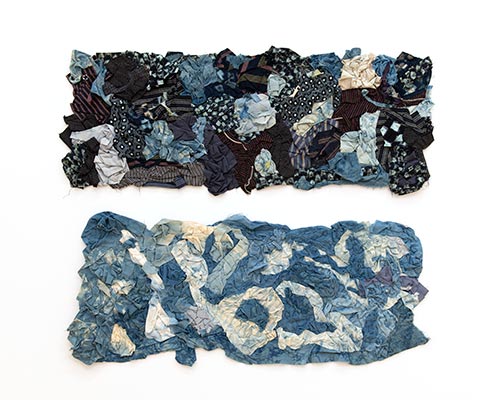
In contrast to the precise geometry of “Morning Glory” are the paired fabric collages entitled “Night and Day”. To construct these hangings, Faeder stitched vintage hand-dyed, hand-woven cotton kimono remnants to nylon netting. Incorporating various shades of blue, these pieces resemble layered cloudbanks in a swirling, stormy sky. The behind-the-scenes nylon netting backing the pieces provides the structure needed to create their three-dimensional effect. They are two of 10 collage works in her “Boro Series”, constructed between 2005 and 2011. Six more pieces in this series are also on display in the exhibit.
Much of Faeder’s work uses repurposed or seemingly-worthless scraps. Seashells, tiny beads, buttons, even mate-less earrings add touches of whimsy and texture. The hand-woven pieces “Blues I Have Known 1” and “Blues I Have Known 2” use narrow strips of fabric – too small for other projects – that were either designed by Faeder or sold in her shop. Nothing is wasted.

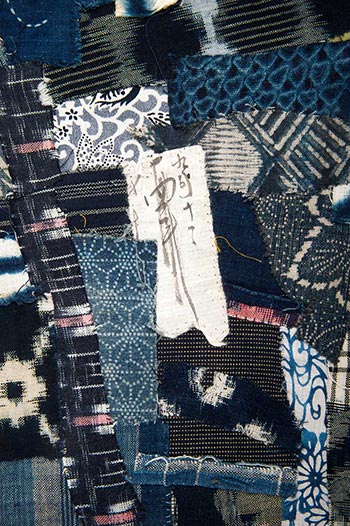
Using vintage materials in her work allows Faeder to extend the lives and honor the spirits of the materials’ makers. Two collages in the “Boro Series” — #8, “Journal”, and #9, “Poem” – incorporate bits of handmade washi paper from an old shopkeeper’s receipt book with hand-dyed cotton indigo kimono remnants. Beauty can be found in anything.
High above the main floor is “Wind & Rain”, a four-square patchwork wall-hanging. Named for its subtle hand-embroidered sashiko-inspired design of swirls and straight lines, this piece was ten years in the making. Some of the antique and vintage fabric pieces were not well suited for this project, but Faeder wanted to preserve them. “It’s not straight, or perfect.” says Faeder, “but that’s okay, because when I look at this piece, my focus is on the individual historical fabrics in the squares.”
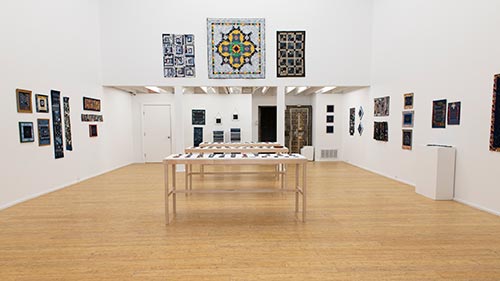
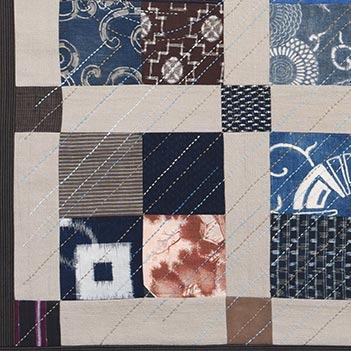
In the center of the room, three cases hold 100 one-of-a-kind cloth amulets (good luck charms), akin to those for sale at Japanese temples and shrines. Created by Faeder across 100 consecutive days in 2019, each palm-sized amulet comes with its own story, based on the fabrics used, its embellishments, and its inspiration. Although this is an impressive body of work, what matters most to Faeder is what she learned about herself from completing this project. She explains, “… the value of the experience (for me) is not in the finished products. It was in giving myself the gift of process, the practice of putting art first, seeing what sacrifice was required and how that, in turn, affected other aspects of my life.”
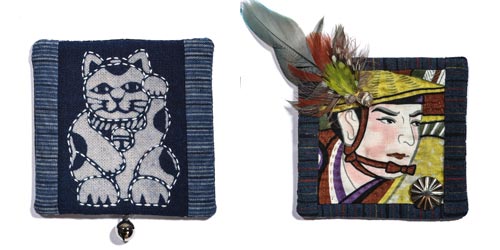
Long-time Lewisburg residents may remember Faeder’s downtown shop, The Beckoning Cat. Amulet #48 (right) is from a line of fabrics Faeder designed called “Fujiwara Heroes.” – Photos by Gordon Wenzel
To see Faeder’s work displayed in this intimate space is itself a gift. But, bear in mind: This exhibit – like that favorite pair of blue jeans and those fragile fabrics sashiko stitches sought to preserve – will not last forever. Make the most of it while you can. And, when it is gone, cherish its memory.
Faeder’s work will be on display through April 30, 2022. For a personal, escorted walkthrough on the museum’s open days, contact her at Susan@QEJAPAN.com.
Photo Credits: Images by Gordon Wenzel and Jeffrey Burrell
A graduate of Bucknell University, Susan Ball Faeder is a nationally recognized teacher, lecturer, and fabric designer. Her work reveals a deliberate immersion in Eastern culture, as evidenced in her use of vintage Japanese textiles and their palette. She lived in Japan and studied the language and traditional culture firsthand for 50 years. In 1989, she started her own company, Quilters’ Express to Japan, as a vehicle for sharing her knowledge of Japanese culture through cloth arts. Through 30 textile tours to Japan, she provided participants with an insiders’ view, arranging personal meetings and workshops with fabric artisans. Her artwork has been exhibited nationally and internationally, including in New York City and Tokyo, and is held in private and corporate collections around the world. A publication featuring her set of 100 cloth amulets is forthcoming from Pretzel City Press. Faeder lives and works in Lewisburg, PA. She is a member of the Lewisburg Arts Council’s Artists’ Guild. Two additional pieces are currently on display at the Lewisburg Arts Council’s Members’ Show at the Public Library for Union County.
Read more about Faeder’s amulets here. Pre-order a copy of her forthcoming book, 100 Amulets.
In this 2020 video made for the Lewisburg Arts Council, Faeder explains her inspirations and techniques used in her textile arts, which include quilting, Japanese sashiko-style embroidery, fiber collage, and weaving.
About MAB
The Milton Art Bank is located at 23 South Front Street in Milton and is open Thursday through Saturday from noon until 6 p.m. Exhibits are always free and open to the public.
Parking is available across the street along 405 South or in the municipal lot between Elm St. and Bound Avenue, next to McDonalds.
For more information, including COVID-19 policies, please visit their website or contact MAB at 570-218-8718 or curious@miltonartbank.com.
